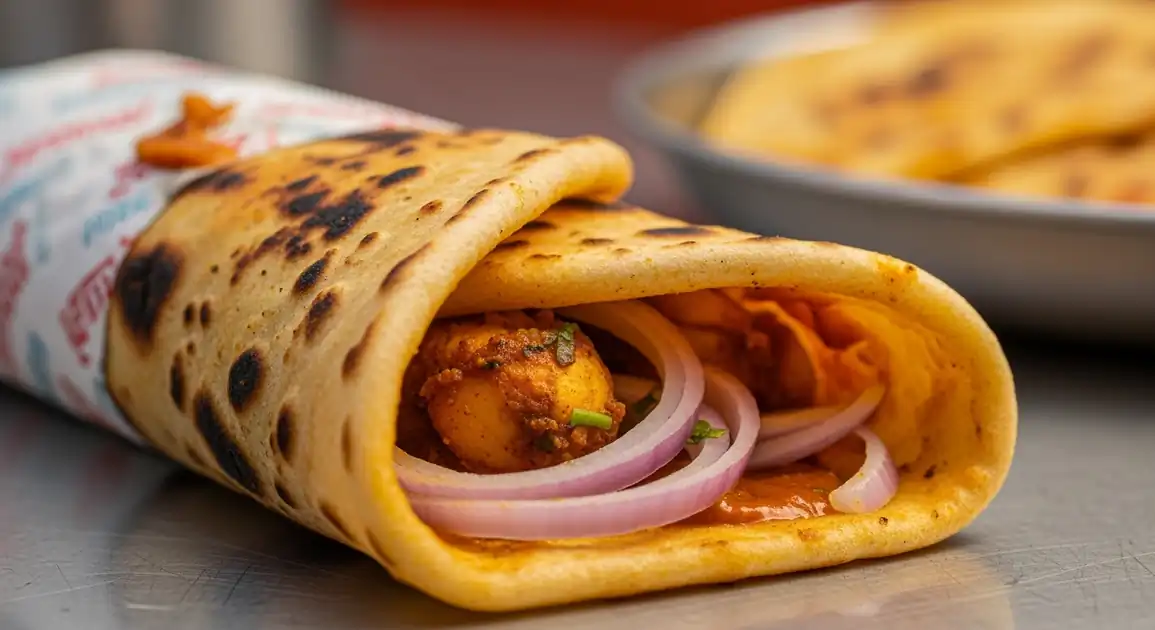Frankie (Indian Wrap)
Frankie (फ्रेंकी / फ्रँकी)

Description
Frankies are a widely popular street food across India, especially in major cities. While originating in Mumbai, variations and numerous stalls can be found nationwide, adapted to local tastes but generally retaining the core concept of a spiced filling in a roll.
Dietary Information
Serving information
Serving style
Served hot, rolled tightly, and wrapped in paper (often branded) for easy handling. Eaten by hand, typically on the go.
Quick facts
Generally 11 AM - 11 PM, with peak hours during lunch and evening.
Safety Tips
What to Look For
-
Filling cooked/reheated thoroughly upon ordering
Ensures meat, paneer, or vegetables are heated to a safe temperature, killing potential bacteria. Look for fillings sizzling on the hot plate.
-
Clean griddle ('tawa') and preparation area
A clean cooking surface and counter reduce the risk of contamination. Avoid stalls with visible grime or old food scraps.
-
High customer turnover
Busy stalls usually mean ingredients are fresher and replenished more often.
-
Use of separate utensils/gloves for handling
Indicates better hygiene practices, especially when handling different fillings or money.
-
Fresh looking onions and sauces
Onions should be crisp, not wilted. Sauces should look vibrant, not dull or separated.
What to avoid
-
Fillings sitting out at room temperature for long periods
Pre-cooked fillings not kept hot are breeding grounds for bacteria, especially meat and paneer.
-
Dirty griddle or utensils
Increases the risk of transferring contaminants to your food.
-
Cross-contamination (e.g., handling raw meat then cooked food/onions without washing)
Significant risk factor for foodborne illness. Observe the vendor's workflow.
-
Visible pests (flies, insects) around the stall
Indicates poor sanitation and potential contamination of food and surfaces.
-
Stalls where vendors handle money and food interchangeably without washing hands/changing gloves
Money carries a lot of germs, which can be easily transferred to food.
Price information
Price range
Budget tips
- Basic Veg/Aloo Frankies are the cheapest (40-80 INR).
- Chicken and Paneer Frankies typically range from 70-150 INR.
- Mutton Frankies are usually the most expensive (100-200 INR).
- Prices are lower at simple street stalls compared to branded outlets or food courts.
Value indicators
- Generous filling amount.
- Freshly made flatbread (roti/paratha).
- Well-balanced spices and sauces.
- Served piping hot.
Where to Find This Dish
Near Colleges/Universities
High concentration of stalls catering to students.
University campuses, Student hangouts
Lunchtime (12 PM - 2 PM), Evening (5 PM - 8 PM)
Near Train Stations/Bus Stands
Convenient spots for commuters.
Major railway stations, Bus depots
Morning rush (limited), Evening rush (5 PM - 9 PM)
Market Areas/Shopping Streets
Popular among shoppers.
Busy commercial streets, Local markets
Afternoon (3 PM onwards), Evening (6 PM - 10 PM)
Vendor Tips
- Look for established brands like 'Tibb's Frankie' for consistency, but don't dismiss popular local vendors.
- Specify if you want egg ('anda') coating or not ('bina anda').
- Observe how they handle fillings – separate sections for veg/non-veg are a good sign.
How to Order
Regional Variations
-
Chicken Frankie
(Chicken Frankie)
Filled with spiced, shredded or cubed chicken.
-
Mutton Frankie
(Mutton Frankie)
Filled with spiced minced or small pieces of mutton (goat meat).
-
Paneer Frankie
(Paneer Frankie)
Filled with spiced cubes or crumbled paneer (Indian cottage cheese).
-
Veg Frankie / Aloo Frankie
(Veg Frankie / Aloo Frankie)
Filled with spiced mashed potatoes (aloo) or mixed vegetables.
-
Egg Frankie
(Egg Frankie / Anda Frankie)
Features a plain omelette or scrambled egg as the primary filling, along with onions and sauces.
-
Cheese Frankie
(Cheese Frankie)
Any filling (chicken, paneer, veg) with added processed cheese.
-
Schezwan Frankie
(Schezwan Frankie)
Uses spicy Indo-Chinese Schezwan sauce along with the filling.
Cultural context
History
The Frankie was invented and popularized in Mumbai in the late 1960s by Amarjit Tibb of Tibb's Frankie. Inspired by Lebanese pita wraps, he adapted the concept for the Indian palate, creating a unique filling, sauce blend, and branding it 'Frankie'. It quickly became an iconic Mumbai street food, spreading across India.
Local significance
Represents quick, affordable, and flavorful urban Indian street food. A convenient and satisfying meal-on-the-go.
Eating customs
- Eaten directly from the paper wrapping.
- Consumed immediately while hot.
- No cutlery needed.